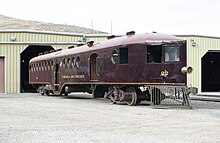One-way vehicle
As a way vehicle are vehicles called that normally always go ahead with the same end (forward) and only exceptionally in the other direction (reverse). Colloquially such vehicles are sometimes short- setters called.
Rail transport
tram


One-way vehicles are often found on the tram . The prerequisite for the use of one-way vehicles is that all end stations of the line being traveled have turning loops , turning triangles or turntables or a ring line is being used. Some companies, for example the Berlin tram , therefore only operate some of their lines with one-way vehicles and others with two-way vehicles. The Wuppertal suspension railway also runs with one-way vehicles, it is legally considered a tram.
In order to remain flexible in the event of unscheduled operational disruptions, deviating routes due to construction sites or during maneuvering, many one-way vehicles are equipped with an auxiliary driver's cab at the rear of the vehicle, also called auxiliary drive switches, rear drive switches or shunting drive switches. However, it is not a bidirectional vehicle because the auxiliary drive switches do not meet the requirements of the Workplace Ordinance for workstations that are occupied for long or continuously, the vehicles can only be operated to a limited extent and the full vehicle speed is often not reached.
For mixed forms (so-called one-and-a-half- direction vehicles ): → False two-way vehicles
Light rail vehicles are mostly designed as bidirectional vehicles . At the beginning of the 1990s, existing DÜWAG one-way articulated vehicles in Essen were equipped with additional doors on the left-hand side so that these vehicles could stop at the center platforms of the tram tunnel. The track buses operating in the tunnel were also equipped in this way.
advantages
- Only one driver's cab is required, which means that the vehicle can be built more cheaply and, in particular, the wiring is simpler. There is also additional passenger space available.
- The driver does not have to change the driver's cab at the terminal points, which enables shorter dwell times and, especially in the event of delays, enables an immediate return trip. In addition, the trains do not meet in the turnout area of the sweeping system . When using sidecars , there is also no need for cumbersome shunting at the transfer terminals .
- If platforms (in the case of double-track lines) are only on one side of the line, doors only need to be present on one side, so more seating or standing space can be offered on the other side of the vehicle.
- All seats can be arranged in the direction of travel without the need to construct expensive foldable backrests or swivel armchairs.
- If a permanent conductor's seat is installed, it is always in the same position, which facilitates the flow of passengers .
disadvantage
- Turning loops and track triangles require more space and can not be created wherever they are operationally necessary.
- The typically narrow radii of turning loops cause relatively heavy wear on the wheel tires, and residents are often annoyed by the corresponding noise development when cornering.
- On single-track lines, when using one-way wagons with doors, platforms only have to be laid on one side on both sides of the track , or the one-way wagons have to be equipped with additional doors on the left-hand side of the vehicle (such as the former Aachen wagons 7103–7113 ).
- The operation with one-way vehicles is much more inflexible in the event of disruptions and construction work, shuttle services are hardly or only uneconomically feasible with two motor coaches coupled to the driver's cab ends, whereby the rear coach cannot be used by passengers.
- The installation of - cheaper - central platforms on double-track routes or stops is not possible without additional entrances on the left side or driving in sections on the "wrong" side.
Duisburg GT8 with auxiliary driver's cab and emergency door
railroad
In the case of railways , one-way vehicles are now the exception compared to bidirectional vehicles . In contrast, steam locomotives with tenders were one-way vehicles; they were preferably driven with the chimney first. The same applied to steam railcars . Examples were railcars and multiple units in North and South America as the McKeen motor coaches that Micheline railcars, the Rail Zeppelin , numerous early railcar types, rail cars , track cars , the Rail Road buses , the Borgward light railcars of Sylt Island Railway or early Talgo units, Talgo I and II. These vehicles had to be turned over track triangles or they were turned in the desired direction on turntables . Other examples are the Karlsruhe light rail cars GT6-80C or some snow plows . Likewise, the so-called pulpit cars usually only run in one direction so that the viewing platform is at the end of the train. Control cars usually only have a driver's cab, but they are not one- way vehicles , because push-pull trains are used in particular for frequent changes of direction.
Road traffic
Almost all road vehicles are one-way vehicles. They are therefore designed in one-way construction. The reverse gear is only used here for maneuvering, for example when parking. Therefore, this term is unusual for road vehicles. Exceptions are, for example, the special vehicles that run in the maintenance tunnel of the Eurotunnel , as they cannot turn around in the tunnel.
Individual evidence
- ↑ Car park list Essen on www.tram-info.de






